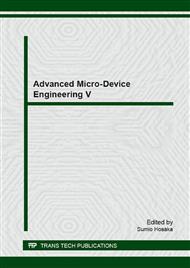p.131
p.141
p.149
p.157
p.167
p.173
p.179
p.185
p.193
Frictional Characteristics Measurement of a Ceramic Aerostatic Linear Bearing
Abstract:
The resultant force acting on the moving part of the ceramic aerostatic linear bearing is measured highly accurately as the inertial force of the moving part of the bearing by means of the levitation mass method (LMM). The measurement results of the ceramic aerostatic linear bearing and metal aerostatic linear bearing of different mass are compared. The regression equation of the ceramic aerostatic linear bearing and metal aerostatic linear bearing are calculated. The ceramic linear bearing and metal linear bearing have extremely small frictional force.
Info:
Periodical:
Pages:
167-172
Citation:
Online since:
May 2015
Price:
Сopyright:
© 2015 Trans Tech Publications Ltd. All Rights Reserved
Share:
Citation:


